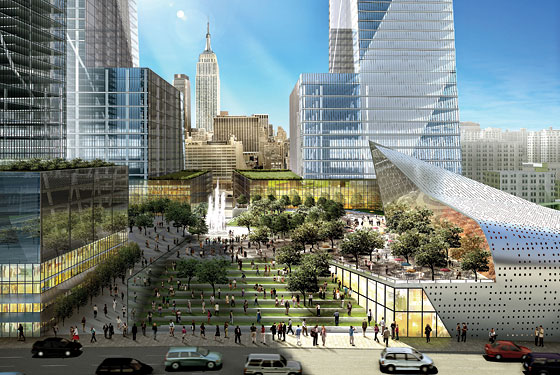
To live in manhattan on the brink of recession is to straddle two future New York Cities, one so vigorous that it makes the recent boom seem wan, another grim, anxious, and subdued. When a crane on East 51st Street snapped off and pulverized an entire walk-up a block away, the accident literalized the fears of collapse and reinforced the view of a city high on a cheap and toxic real-estate rush. Suddenly, all those cranes quivering on the skyline seem threatening, 250 stalky behemoths engaged in a spasm of giddy construction while down at ground level a flood of foreclosures erodes the country’s financial foundations.
New York always lives in a dream, but it has rarely felt more surreally deluded than it does right now. Wall Street lurches and stumbles on each hour’s infusion of bad news, yet the market’s minions still grab two reservations for dinner at Babbo four weeks ahead. Meanwhile, developers try to distinguish their product from the flood of bland condos that claim to “redefine luxury” by catering to self-indulgence. A new Upper West Side high-rise offers breakfast-in-bed service, a marketing move that smacks more of desperation than decadence. Will anyone who is thinking of spending a million or two on a condo be swayed by the promise of croissants?
Real estate is supposed to be real, but these days it’s the province of fabulists. Boom-time dreams for Coney Island, Pier 40, and a new Madison Square Garden got bad news last week. After years of spinning fantasies of a Brooklyn Oz designed by that purveyor of fairy-tale architecture, Frank Gehry, Bruce Ratner has finally admitted that his Atlantic Yards ambitions have vaporized—or, in builders’ parlance, that the credit crunch “may hold up” most of the project. But fantasies have consequences: The condemned buildings will keep coming down, and the basketball arena will go up, leaving that part of Brooklyn ravaged, not improved. Now the parcel might be sold off and developed piecemeal, one mediocre tower at a time.
Ratner has called off his party, but elsewhere the city still plows ahead. Unfinished towers sprinkle debris on passersby, producing tomorrow’s glut of vacant penthouse pleasure domes. The ebbing Bloomberg administration is desperate to nudge its array of megaprojects a little further toward inevitability before it bows out, which helps to explain the tone-deaf proclamation of grandiloquent plans for the Hudson Yards. Tishman Speyer will pay the MTA $1 billion for the right to build a $2 billion deck over the tracks to support 10 million square feet of office space and 3,000 apartments in a cluster of super-skyscrapers. All this plenty is supposed to spur the westward march of the midtown business district, but the plan overlooks the prairie’s worth of cubicles and conference rooms coming to the World Trade Center site.
It’s true that with this deal Tishman Speyer demonstrates enormous confidence in the city’s future, for which the MTA is so grateful that it’s happy to accept whatever the developer wants. That’s a waste of leverage. It could be a great and spacious riverside campus, instead of a tired stand of towers. The entire project won’t be completed until today’s children are old enough to go to work there, but the moment to demand an inventive master plan is now.
Have good intel? Send tips to intel@nymag.com.
